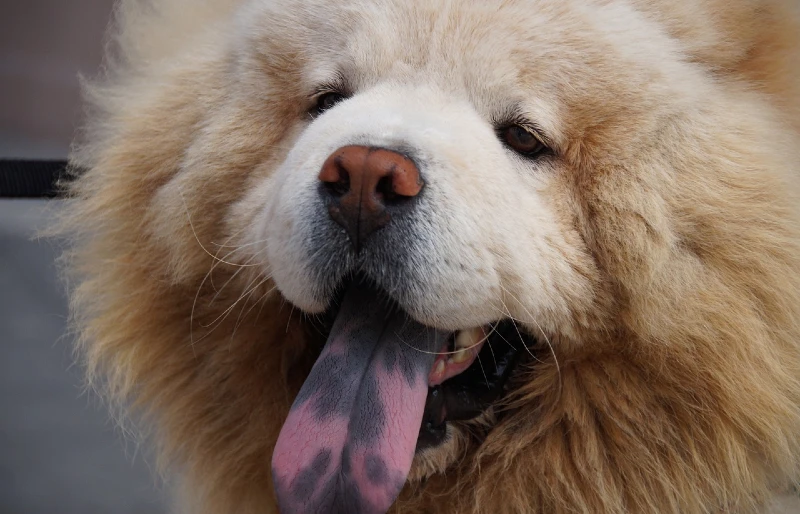Why Do Dogs Have Black Spots on Their Tongue? Vet-Approved Facts & FAQs
Updated on

You may have noticed that some dogs have black spots on their tongues. But are these markings an inherent aspect of certain dogs’ genetic makeup, similar to their coat pattern, or are they a sign of an underlying health issue?
Fortunately, these black spots are most often merely a result of pigmentation, akin to birthmarks. If your dog has dark marks on their tongue, there’s typically nothing to worry about. That said, there are rare instances where these spots may indicate something more serious and require a trip to the vet.
Let’s go through these specific cases using the latest available scientific evidence and vet-approved facts and explore in more detail the strange tongue “birthmarks” that make some dogs so special.
Why Do Some Dogs Have Black Spots on Their Tongue?
The bluish-black spots on dogs’ tongues are typically nothing more than pigmentation. Just like specific breeds exhibit darker “points,” or markings, on their fur, spots present on the tongue are simply areas where specialized skin cells—called melanocytes—are producing more of the pigment melanin.
While certain genetic traits in domestic dogs can be attributed to selective breeding, the presence of spotted or black tongues offers no discernible advantage or disadvantage to a dog. Therefore, from an evolutionary standpoint, these black spots seem to lack any known purpose.
In other words, they are just a random accumulation of pigment in some sections of the tongue.
What Are the Black Spots “Made” Of?
Melanin is the pigment that creates the various tones and colors of human and animal skin, hair, and eyes. This pigment is produced by specialized cells called melanocytes, and its production is controlled by hormones and the genes received from the dog’s parents.
In the absence of melanin, the skin will be a pale white hue with hints of pink (due to blood circulation beneath). For example, albino dogs lack the genes needed to produce melanin, hence their white coats, pink noses, and blue eyes.
Melanin tends to be evenly distributed in the skin, but it sometimes builds up in certain areas, leading to freckles and age spots in humans or black spots on your pup’s skin and tongue.

What Should Normal Black Spots Look Like?
The texture of normal black spots should match the rest of your dog’s tongue. They should not be raised, rough, or change shape or size. If they have been present for a while, it’s likely that they’re harmless. However, just like human birthmarks, any changes in their characteristics should be noted.
Colors other than bluish-black and an unpleasant odor are causes for concern, as these might indicate a more serious issue. This applies if a spot suddenly appears and grows rapidly or changes in color or shape. But in general, normal spots begin light and small, gradually darkening over time.
When Should You Take Your Dog to the Vet?
A sudden change in the color of your dog’s tongue is more concerning than black spots that have been there since birth. According to PetMD, this may indicate a medical emergency.
- If your dog’s tongue turns dark red, purple, or blue, it could be a sign of heatstroke, exposure to toxins, heart or lung disease, or electric shock.
- If your dog’s tongue turns white or pale pink, it may be a sign of severe anemia resulting from internal bleeding.
- If a dark spot suddenly appears, grows, or changes shape, color or texture it could indicate a tumor that needs to be seen.
Are Dark Spots the Same as Hyperpigmentation?
No. While black spots are generally harmless, hyperpigmentation in dogs is an abnormal reaction of the skin to certain diseases. It is a darkening and thickening of the skin. The affected areas become rough and light brown to black and are usually found on the legs, belly, or groin.
Besides the thickened patches of skin, dogs with hyperpigmentation often show other signs of illness, such as redness, scaling, crusting, itching, and hair loss.

Which Dog Breeds Commonly Have Black Spots on Their Tongue?
Any dog can have black spots on their tongue, whether they are purebred or mixed. That said, here are a few examples of breeds that frequently have spotted tongues (or completely pigmented tongues in the case of the Chow Chow and Shar Pei):
Tips for Keeping Your Dog’s Mouth Healthy
Now that you know what the black spots on your dog’s tongue are and when they should be a cause for concern, you’ll probably want to check your dog’s mouth more often to make sure their oral hygiene remains excellent.
- Brush their teeth. You should brush your pup’s teeth regularly with dog-friendly dental products. Aim for a routine that fits your pet’s comfort level, whether that’s daily or several times a week. However, if those toothbrushing sessions prove impossible—if it makes them overly anxious, scared, or downright aggressive—you may need to consider teeth-brushing alternatives.
- Replace the toothbrush with dental wipes. If your pup despises having their teeth brushed, you can try using dog dental wipes. While they do not replace brushing, they can still be effective in reducing plaque and tartar buildup on your dog’s teeth.
- Opt for an appropriate diet for dog oral health. A specially formulated diet can support your pup’s dental health. For example, the texture of these high-quality dry kibbles can help scrape debris from their teeth.
- Don’t skip the annual dental checkups. Even if your dog hates it, a regular dental checkup with the vet is vital. They should go at least once a year, according to the American Animal Hospital Association’s dental care guidelines. A good dental brushing routine at home is essential, but nothing can replace a thorough professional cleaning.
Frequently Asked Questions (FAQs)
Can Black Spots Develop Over Time?
Yes. Some puppies are born with spotted tongues, while others will develop these markings later in life.
What Other Types of Spots Can Dogs Get on Their Tongue?
A dog that has suffered some kind of injury to the mouth (for example, eating something sharp like a piece of meat bone) may have sores, burrs, or scars on the tongue. These lesions can be pale pink, brown, or red, depending on the nature of the injury. They may be accompanied by bleeding, swelling of the gums, excessive salivation, foul odor, and pain. If you notice any of these signs, a trip to the vet is in order, as they may indicate more serious issues.
Dogs can also develop tumors on or under their tongue. These usually appear as raised, irregular shaped lumps that may vary in color from pink or red to brown or black. Any new lumps or colorings on your dog’s tongue should be seen by a vet.
Can Black Spots Cause Discomfort to Dogs?
Typically, black spots are benign and cause no discomfort or pain. But if you have any concerns or notice any changes in your dog’s behavior, you should ask your vet to take a look in their mouth.

Should I Be Concerned If My Dog’s Black Spots Change in Appearance?
Yes. If the spots change significantly or are accompanied by other signs, it’s best to have your dog examined by a vet to rule out any issues.
Are There Any Serious Health Concerns Associated With Black Spots on the Tongue?
Sometimes, spots in the mouth or tongue (without necessarily being black in color) can indicate a tumor. For example, melanomas are one of the most common oral tumors in dogs and are usually aggressive. The lesions can appear as thickened, pigmented nodules anywhere in the mouth.
Besides mouth and tongue lesions, signs of oral melanoma in dogs can include bad breath, drooling, panting, tooth loss, bleeding, lack of appetite, pain, and swelling of the face.
Since this type of cancer grows rapidly and tends to metastasize to the lungs and lymph nodes, it must be detected as early as possible.
Final Thoughts
There are two important things to remember about black spots on your dog’s tongue:
- In the vast majority of cases, they are completely harmless and only add to the uniqueness of your beloved pup.
- However, just like freckles or birthmarks, a rapid change in color or texture can indicate a more serious problem.
For this reason, if the spots begin to change rapidly or the texture is raised or different from the rest of the tongue or gums, call your vet to make sure your dog is okay. Above all, do not skimp on toothbrushing sessions!
See also:
- My Dog Ate Chalk: What to Do Next? (Vet-Approved)
- Why Do Dogs Sleep With Their Tongue Out? 6 Vet-Approved Reasons & FAQ
Featured Photo Credit: Kittima05, Shutterstock













